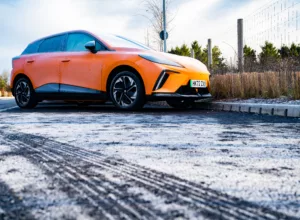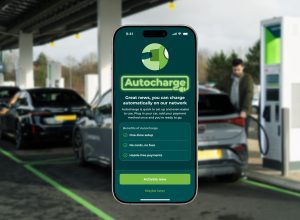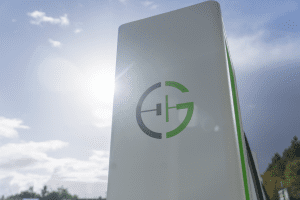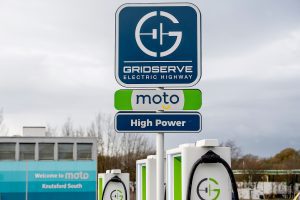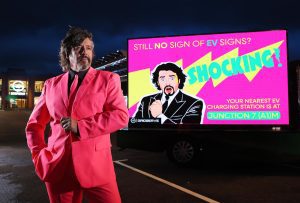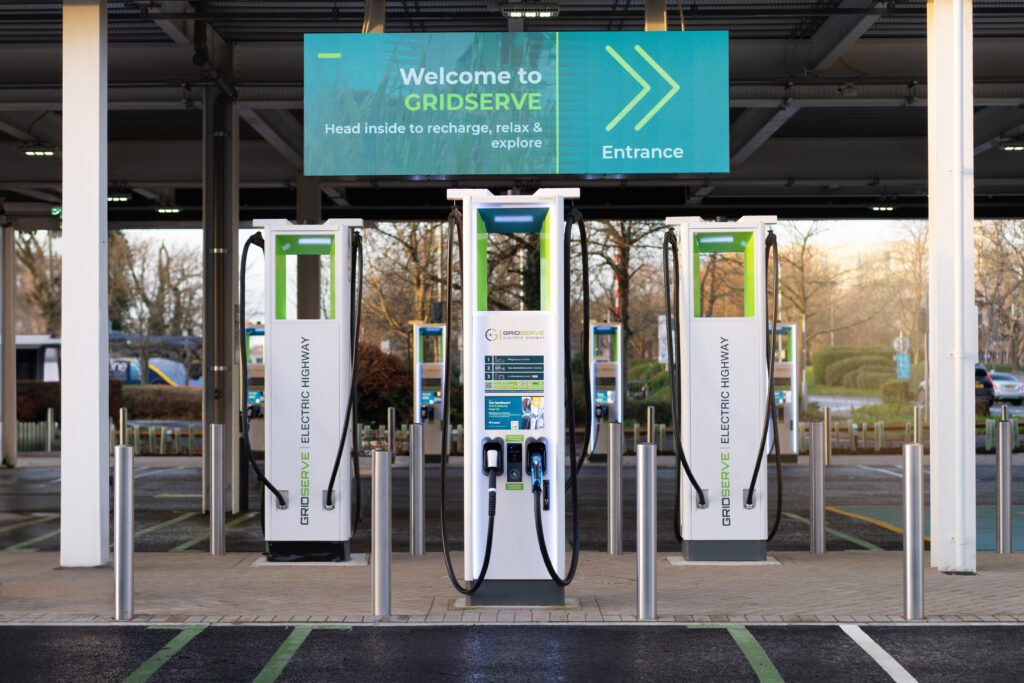

Whenever you waft silently into a electric vehicle charging bay, plug in and then grab a coffee from Costa Coffee, do you ever think about what is going on behind those high frequency whines and massive fridge-like shapes? Do you ever ask how does EV charging work?
Well, let us tell you exactly that.
At GRIDSERVE, we’re proud of our small benevolent army of engineers that are making sure all the EV charging technology at more than 190 EV charging locations are consistently full of renewable energy electrons and working flawlessly, day and night.
Whether you’re using an Electric Forecourt®, Electric Super Hub or Electric Retail Hub, we know speed, ease of use and availability of charging stations are the priority, so we’re doing everything we can to further expand this award-winning ultra-rapid charging network.
How does EV charging work?
When it comes to electric vehicle charging, we tend to have a double act performing all the hard work. Backstage is something called the power cabinet, an anonymous white box that is often hidden from view.
Its job is to safely convert the high voltage, three-phase Alternating Current (AC) that GRIDSERVE receives from the grid into Direct Current (DC) that can directly charge an electric car’s battery. All batteries runs on Direct Current, so you can think of your EV and our electric car charging points in a similar way to your mobile phone and its charger. Only much bigger.
Why does the grid use AC then, we hear you ask? Partly because AC can be transmitted across long distances without much energy loss, and partly because AC power can be stepped up or down in voltage with simple and low-cost transformers.
One more thing to note about DC vs AC, is that DC charging is for ultra-rapid and rapid chargers whereas AC charging will be used for slower units or home charging points. The AC to DC conversion on slow chargers is done in your car – that’s why it’s slower and less efficient.
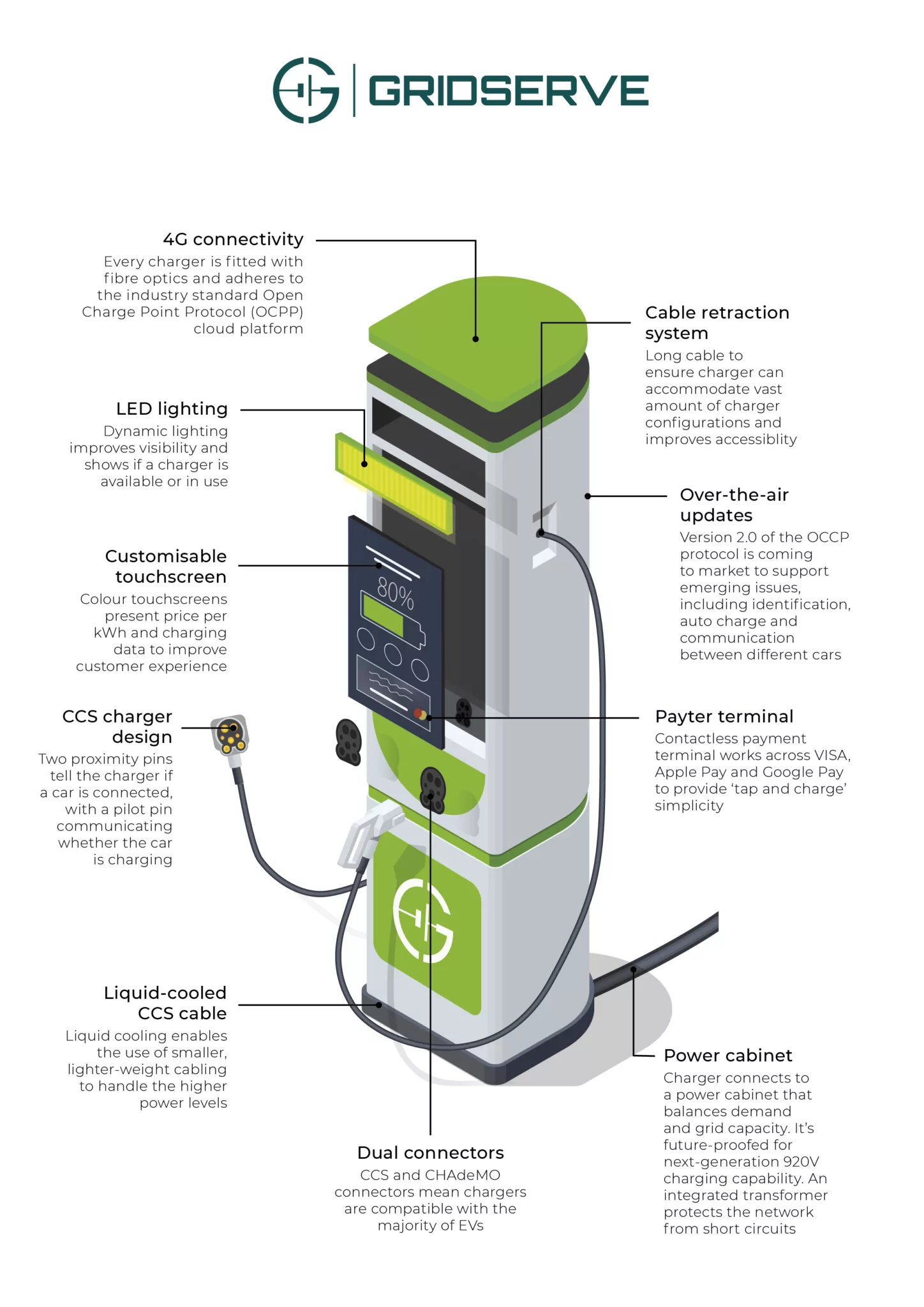
Inside an EV charger
Power electronics covered, we move to the main event of how to charge an electric car. The EV charger itself tends to be located at the end of the charging bay, surrounded by safety bollards, clothed in jazzy stickers and featuring a digital screen to display pricing, a contactless payment terminal and one or two EV charging connectors.
In most cases, you’ll find the more popular CCS connector, although we continue to provide CHAdeMO connectors to ensure every electric vehicle on sale can use our network.
A figure expressed in ‘kW’ or kilowatts is writ large at the top of the charging totem and this describes the charging capacity or maximum power: the higher the kW figure, the faster the charge rate will be.
Our latest High Power chargers are 360kW-capable, meaning they can add 100-miles of electric car range in just 5 minutes. Given such high rates of power, the charging cables feature liquid cooling to ensure they can efficiently deliver such a high amount of current to the vehicle. This explains why those cables can often feel quite heavy.
Despite that peak power output, it’s worth remembering that all electric vehicles are controlled by their in-car battery management systems. So, the maximum rate at which anybody can charge is always dictated by the vehicle, rather than the charger.
Connecting to your electric vehicle
After removing the connector from its holster and plugging into the vehicle, the charger communicates with the electric vehicle’s battery management system and the GRIDSERVE data centre to facilitate the so-called ‘handshake’ and start the charging session.
Every charger on our network is fitted with fibre optic comms and adheres to the Open Charge Point Protocol (OCPP) cloud platform, the internationally recognised standard for communicating in the EV charging industry.
From processing payments to recognising customer accounts, or even facilitating future services like auto charging, there are so many connected devices within this chain and they all need to be able to understand one another to avoid miscommunication.
Following a series of gateway checks, including protocols for contactless payment, the charging session will start. In real time, the EV charger is then monitoring all communications, calculating how much electricity is needed, at what charging speed and at what cost.
This information is shared with the best-known EV charging apps – so all drivers know the real-time status of this charger – but the data is also analysed by GRIDSERVE Technologies to gather insight regarding this specific charger’s performance, which can then be benchmarked against the rest of the network.
It’s this information that helps to foster a pathway for continuous improvement, which is how we keep improving the EV charging experience for all our customers.
Why is the electric vehicle charging speed slow?
There are a range of factors that impact charging speed – and often it’s not related to the charger itself. Yes, the charging capacity of our fastest units are capable of adding 100 miles of electric car range in just 5 minutes but the possibility of achieving that is dictated by a number of factors:
- Your electric vehicle: The charging speed of the charger can only go as fast as your electric car is capable of accepting charge. Most cars have a maximum charging rate of around 150kW.
- Your vehicle’s battery: Lithium-ion batteries charge fastest when they have a charge of between 20%-80%. If your battery is above or below this, the charger will not be able to hit maximum charging speed – this is known as a charging curve.
- Temperature: Lithium-ion batteries work best in moderate climates. In extreme heat or extreme cold, performance will be limited and charging will take a little longer. It’s best to pre-condition your battery in advance of fast charging.
For more on how EV charging works explore our complete guide to how to charge an electric car, including a step-by-step journey from how long charging an EV takes and how much electric car charging costs.
